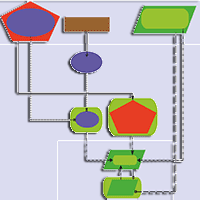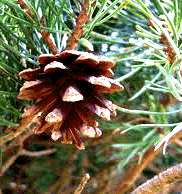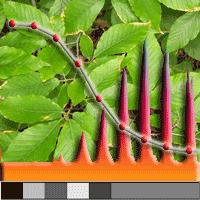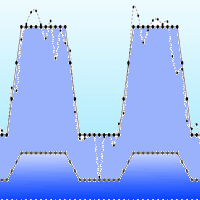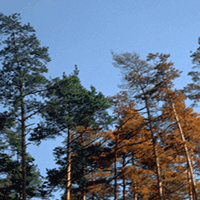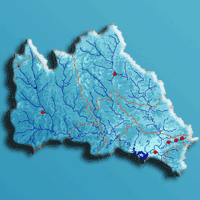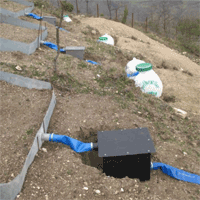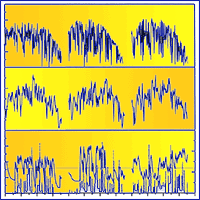
Growing season water balance of an inner alpine Scots pine (Pinus sylvestris L.) forest
Gerhard Wieser (1) , Andreas Gruber (2), Walter Oberhuber (2)
iForest - Biogeosciences and Forestry, Volume 11, Issue 4, Pages 469-475 (2018)
doi: https://doi.org/10.3832/ifor2626-011
Published: Jul 02, 2018 - Copyright © 2018 SISEF
Research Articles
Abstract
We estimated components of the water cycle of a 150-year-old Pinus sylvestris forest in an inner Alpine dry valley of the Tyrol, Austria throughout five growing seasons. Forest canopy transpiration (TC) was measured by sap flow measurements scaled to the stand canopy level. Estimates of understory transpiration and forest floor evaporation (ETU) were derived from the soil water budget method, while interception (I) was modelled. Growing season cumulative evapotranspiration (ET = TC + ETU + I) varied between 256 and 322 mm or 51 to 79% of the growing season precipitation. The contribution of TC, ETU, and I to ET were 33, 40 and 27% respectively. Although these values of each layer (evapo)-transpiration are in good agreement with studies carried out in other European Scots pine forests, our estimated growing season total forest water use (Ttot = Tc + ETu) of 200-244 mm is at the lower end of values reported for coniferous forest ecosystems, and thus reflects an adaptation to the low shallow soil water availability. We conclude that Scots pine forests in inner alpine dry valleys are able to cope with high evaporative demand, even when shallow soil water availability is limited.
Keywords
Forest Water Balance, Scots Pine, Dry Inner Alpine Valley, Evapotranspiration, Interception, Runoff
Authors’ Info
Authors’ address
Department of Alpine Timberline Ecophysiology, Federal Research and Training Centre for Forests, Natural Hazards and Landscape (BFW), Rennweg 1, A-6020 Innsbruck (Austria)
Walter Oberhuber
Department of Botany, Leopold-Franzens-Universität Innsbruck, Sternwartestraße15, A-6020 Innsbruck (Austria)
Corresponding author
Paper Info
Citation
Wieser G, Gruber A, Oberhuber W (2018). Growing season water balance of an inner alpine Scots pine (Pinus sylvestris L.) forest. iForest 11: 469-475. - doi: 10.3832/ifor2626-011
Academic Editor
Emanuele Lingua
Paper history
Received: Sep 06, 2017
Accepted: May 07, 2018
First online: Jul 02, 2018
Publication Date: Aug 31, 2018
Publication Time: 1.87 months
Copyright Information
© SISEF - The Italian Society of Silviculture and Forest Ecology 2018
Open Access
This article is distributed under the terms of the Creative Commons Attribution-Non Commercial 4.0 International (https://creativecommons.org/licenses/by-nc/4.0/), which permits unrestricted use, distribution, and reproduction in any medium, provided you give appropriate credit to the original author(s) and the source, provide a link to the Creative Commons license, and indicate if changes were made.
Web Metrics
Breakdown by View Type
Article Usage
Total Article Views: 47838
(from publication date up to now)
Breakdown by View Type
HTML Page Views: 40807
Abstract Page Views: 3270
PDF Downloads: 2800
Citation/Reference Downloads: 9
XML Downloads: 952
Web Metrics
Days since publication: 2718
Overall contacts: 47838
Avg. contacts per week: 123.20
Citation Metrics
Article Citations
Article citations are based on data periodically collected from the Clarivate Web of Science web site
(last update: Mar 2025)
Total number of cites (since 2018): 7
Average cites per year: 0.88
Publication Metrics
by Dimensions ©
Articles citing this article
List of the papers citing this article based on CrossRef Cited-by.
References
Scheffer/Schachtschabel - Lehrbuch der Bodenkunde [Textbook of soil science]. Spektrum Akademischer Verlag, Heidelberg, Germany, pp. 569. [in German]
Gscholar
Methodische Beiträge zur Erfassung der Wechselwirkung zwischen Wald und Wasser [Methodological contributions to the understanding of the interaction between forest and water]. Forstarchiv 35: 229-241. [in German]
Gscholar
An introduction to environmental biophysics (2nd edn). Springer, New York, USA, pp. 286.
Gscholar
Vegetation Mitteleuropas mit den Alpen in ökologischer, dynamischer und historischer Sicht [Vegetation of Central Europe including the Alps in an ecological, dynamic and historical perspective]. UTB, Ulmer, Stuttgart, Germany, pp. 1334. [in German]
Gscholar
World reference base for soil resources. FAO, World Soil Resource Report, vol. 103, Rome, Italy, pp. 145.
Gscholar
Das Klima der Alpen im Raume von Tirol. Monographien zur Landeskunde Tirols; Folge I [Climate of the Alps in the Tyrol area. Monographs on the regional studies of Tyrol; Part I]. Universitätsverlag Wagner, Innsbruck, Austria, pp. 454. [in German]
Gscholar
Water balance of a boreal Scots pine forest. Boreal Environment Research 15: 375-396.
Gscholar
Environmental controls over carbon dioxide and water vapor exchange of terrestrial vegetation. Agricultural and Forest Meteorology 113 (1-4): 97-120.
CrossRef | Gscholar
Analysis of three severe droughts (1995-2006) and their effects on Pinus sylvestris transpiration and physiological response in a montane Mediterranean research catchment (Vall-cebre, Spain). Geophysical Research Abstracts 10: EGU2008-A07353.
Gscholar
Tree canopy and field layer transpiration in Scots pine stands. In: “Changes of Atmospheric Chemistry and Effects on Forest Ecosystem” (Hüttl R, Belmann FK eds). Kluwer Academic Publishers, Dordrecht, Netherlands, pp. 97-110.
Gscholar
Driving factors of a vegetation shift from Scots pine to pubescent oak in dry Alpine forests. Global Change Biology 19: 229-240.
CrossRef | Gscholar
Biogeochemistry - an analysis of global change. Academic Press, Waltham, MA, USA, pp. 672.
Gscholar
Evaluation des besoine d’eau d’irrigation, evapotraspitarion potentielle [Assessment of the needs of irrigation water, potential evapotranspiration]. Annals Agronomique 12: 13-49. [in French]
Gscholar
Forest ecosystems. Analysis at multiple scales (2nd edn). Academic Press, San Diego, California, USA, pp. 370.
Gscholar
Understory contribution to stand total water loss at an old Norway spruce forest. Verhandlungen Gesellschaft für Ökologie 26: 69-77.
Gscholar

